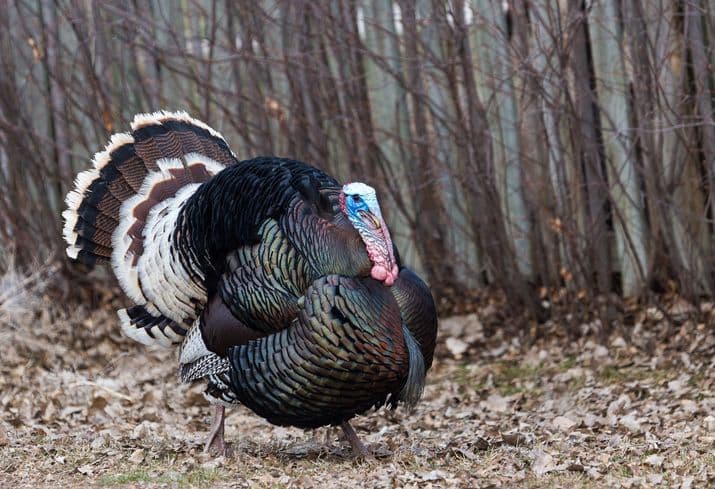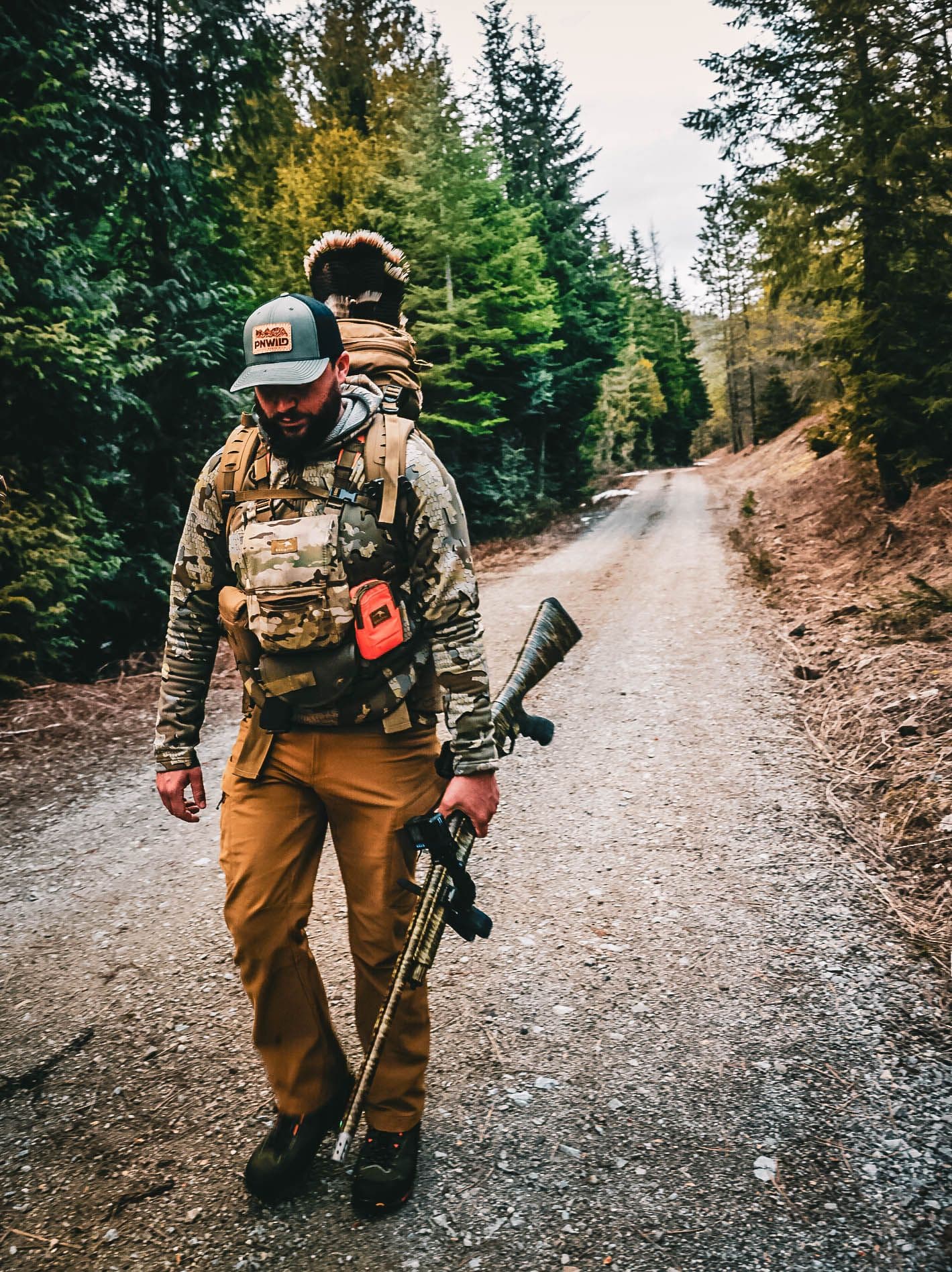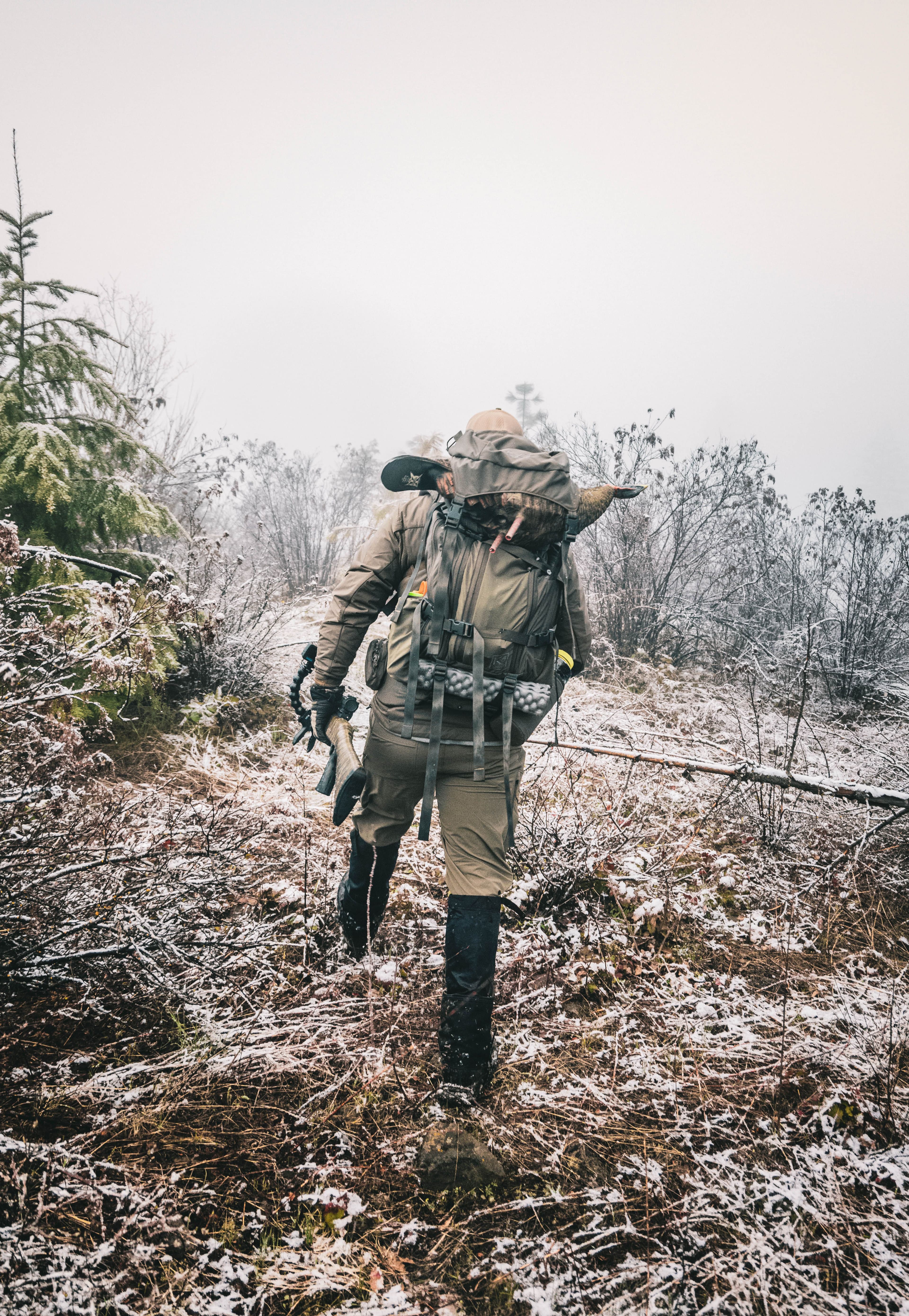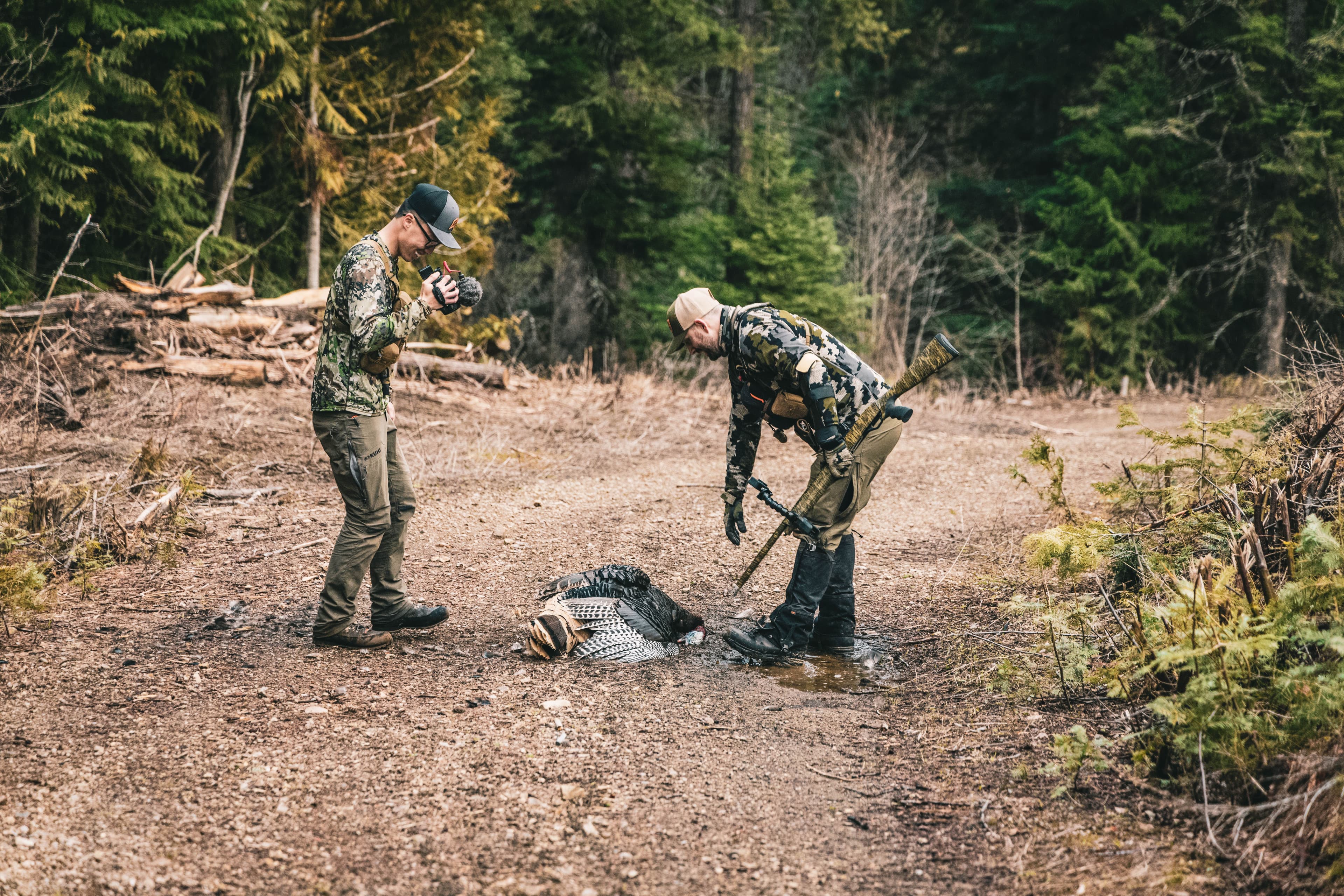Advanced Turkey Hunting for Western States: Mastering the Terrain and Tactics


Justin Hunold
02/09/2024
Turkey hunting in the Western states presents unique challenges and opportunities for Turkey hunters seeking a new kind of adventure. The huge landscapes of the West offer a variety of terrains, from mountainous woodlands to open ranges, which are home to elusive turkey subspecies such as the Merriam's and Rio Grande. Understanding the behaviors and habitats of these birds is a crucial aspect for those looking to elevate their hunting experience and expand their range.
The vast public and private lands provide ample hunting grounds, but knowledge of hunting laws, Turkey behavior, and peak seasons is an absolute must to be successful out west. These advanced Turkey Hunting tips and tactics tailored to the rugged terrain can transform an ordinary hunt into an extraordinary adventure.
Understanding Turkey's Subspecies and Habitats
In advancing turkey hunting strategies, hunters must identify subspecies and understand their habitat preferences and general habits. Recognizing the variations in physical and behavioral characteristics and habitat requirements is a must to bag a Tom in the western states.

Distinguishing Turkey Subspecies
The western states predominantly host two subspecies of wild turkey: Merriam's and Rio Grande.
Merriam's Wild Turkey (Meleagris gallopavo merriami)
Feathers: Tipped with white, especially on the tail fan and lower back
Range: Mostly found in ponderosa pine forests across mountainous regions, extending from Arizona and New Mexico to the edges of Colorado and South Dakota.
Rio Grande Wild Turkey (Meleagris gallopavo intermedia)
Feathers: Copper and buff-colored with less white than Merriam's, and tail feathers tipped with a yellowish hue
Range: Favor the drier, more open spaces such as creek bottoms, oak woodlands, and canyons often found in Kansas, Oklahoma, Texas, and parts of Colorado and New Mexico.
Habitat Preferences Across the West
When chasing wild turkeys in the western states, hunters must pay close attention to the distinct environmental cues associated with each subspecies—ideal habitats for turkey populations combine roosting trees, feeding areas, and water sources. When in doubt, find water and work out from there.

Merriam's Habitat
These birds thrive in more elevated, forested environments, such as western forests where mixed conifer and aspen stands are typical, often near ridges or plateaus. Providing a strut zone and security cover.
Preferred Terrain: Timbered Mountains with nearby meadows for foraging.
Rio Grande Habitat
On the other hand, Rio Grande turkeys are adaptive to semi-arid conditions, often found along creeks and riverine systems surrounded by mesquite, scrub oak, and cottonwood.
Preferred Terrain: Creek Bottoms and riparian areas amidst open grasslands or shrublands.
Hunters should also consider that while Merriam's turkeys are typically associated with vast expanses of woods like national forests, Rio Grande turkeys often exploit resources found on both tight lots and huge expanses of land. Looking into access for hunting across these different land designations can enhance the hunting experience.
What are the recommended gear and techniques for successful turkey hunting in cold morning conditions?
Essential gear for cold mornings includes layered clothing for warmth, a pop-up blind or natural cover, and calls suited to the quietness of dawn. We advise light calling and patience in tough, cold conditions.
Tactics for Western Turkey Hunting
Hunting turkeys in Western states takes a real knowledge of scouting and calling techniques. This section explores the strategies that lead to successful hunts by focusing on identifying signs of turkey activity and the effective use of decoys and calls.
Scouting for Turkey Sign
Before a hunter can outwit a gobbler, they have to understand where the turkeys are. Scouting is a foundational component and should begin with E-scouting, then progress to maybe a drive around local roads and trails, then hiking through probable locations with some boot leather, and if time permits, glassing—using binoculars to spot turkeys from a distance.
Hunters should look for tracks, unmistakable three-toed marks, and droppings, indicating the turkey's sex (males have j-shaped droppings, while females feature spiral-pattern droppings). These are great signs to keep an eye out for while driving back roads or on hiking trails while scouting. Discovering a roost site, where turkeys settle for the night, can pinpoint their morning or evening location. The gobble of a turkey, often heard at dawn or twilight, can be the key to a successful hunt.

Scouting for wild turkeys in the expansive wilderness of the Western states requires a blend of patience, skill, and a deep understanding of the turkey's behavior and habitat. Here's a deeper dive into the vital scouting actions that can significantly increase your chances of a successful hunt.
E-Scouting
These days, we all have mapping apps, including on our phones. Even using our maps on the Infinite Outdoors App is a start. These apps provide a great starting point for every new hunting experience. I like to focus on water when searching for both of these subspecies of birds; in fact, water is my starting place for almost all E-scouting.
Another thing Toms want in the spring is a place to strut; open fields, meadows, or sparse cover in a river bottom can be a perfect strut zone. Don’t overlook any area that might have a break in cover, a hilltop, or even a two-track. Those birds will fan out in any opening they can find. Closer to water and food is even better.
Observation with Binoculars (Glassing)
Glassing, or using binoculars to observe wildlife from a distance, is an essential tool in the turkey hunter's kit. Full stop. I always carry good binos when turkey hunting especially out west. High-quality optics can reveal the subtle movements of a turkey or a flock across a meadow or through sparse woodland, often long before you're close enough to spook them. When glassing for turkeys, look for the iridescent sheen of their feathers, the movement of feeding, or the distinctive shapes of their heads and tails as they move through their environment. Glassing helps spot turkeys and observing their behavior, which can give you insights into their feeding patterns, preferred terrain, and how they interact with their surroundings. Use your glass to cover the ground, not your feet. You can’t spook birds by glassing them, you sure can by trampling through their flock.
Identifying Tracks and Droppings
Tracks and droppings are like the breadcrumbs left behind by turkeys, guiding you to their most frequented areas. Turkey tracks are distinctive, with three forward-facing toes and one smaller toe facing backward. Finding a trail of these tracks can lead you to feeding grounds, water sources, or dusting areas. Similarly, turkey droppings provide clues; hens leave behind spiral-shaped droppings, while toms produce j-shaped droppings. This is the same as big game hunting. Hunting is hunting. Find the sign; you can establish the presence of turkeys in the area and potentially their roosting spots.
Locating Roosting Sites
Roosting sites are crucial to pinpoint when scouting for turkeys. These are the areas where turkeys retreat to sleep and rest, typically in large, mature trees that offer protection from predators. If I can find an isolated tree near water, generally, I’m in the money. In the West, ponderosa pines are a favorite roosting tree for Merriam's turkeys. Identifying these sites involves looking for large trees with wide, sturdy branches, often near a water source. Evidence of roosting, such as feathers and droppings, can also be found on the ground beneath these trees. Locating a roosting site can give you a leg up. You can position yourself along a route turkeys are likely to take when they fly down in the morning or return at dusk.
Listening for Gobbles
The gobble of a Tom is not just a call; it's a beacon. During the spring mating season, toms gobble to attract hens and assert dominance over other males. This powerful, resonant sound can travel long distances, providing a critical auditory clue to a turkey's location.
Early morning, just before sunrise, is the prime time to listen for gobbles, as toms are most vocal while still on the roost. This is a great time to walk game trails, ridge tops, or river bottoms to listen for your tom if you didn’t find a roost tree.

Similarly, as they're settling back in for the night, late afternoon can be another time to listen. By sneaking toward the source of the gobble, you can pinpoint a tom's location without visual contact, then setting up to take advantage of that birds uppity nature. He wants to be near other birds, and he wants to establish dominance.
Incorporating these scouting techniques into your pre-hunt preparation will increase your understanding of turkey behavior and give you an overall experience in this beautiful western wilderness. Remember, successful turkey hunting in the West is as much about the journey and connection with nature as it is about pulling the trigger.
Decoy and Calling Techniques
Once the sign (or birds) have been located, the hunter should use decoys and calling techniques to draw gobblers into range. Effective decoy use can create the illusion of a hen or a competing tom, which can lure a gobbler. Competitive by nature, a Jake or Strutting tom decoy with a few hens can set a gobbler off. Decoys should be placed in clear visibility and within the effective range of the hunter's weapon to maximize the chances. Generally, the decoys should be just off to the side of the direct line of sight for the hunter so the incoming toms aren’t looking through the decoys at the hunter. Turkey calling takes practice—both in sound creation and timing. Focus on calls that imitate the hen's yelp, which can entice a tom looking for company. I’m a big fan of purring softly and letting the Tom dictate my call volume (both quantity and sound).. However, calls should not be overused, as turkeys can become wary and then the jig is up. Mixing up calling patterns and including soft purrs or clucks may keep a gobbler's interest and lead to a successful hunt.
Successful turkey hunting hinges not just on finding turkeys but on effectively attracting them within range. This requires a strategic approach to using decoys and calls and the ability to adapt to the situation based on the turkey's response. Let's delve deeper into these effective techniques.
Correct Decoy Placement and Variety
Decoys serve as a visual lure to attract turkeys, simulating the presence of other birds and encouraging them to approach. The key to effective decoy placement is making them visible yet natural-looking. In open areas, position your decoys where they can be seen from a distance but in a setting that mimics natural turkey behavior. Nature is random, so the decoys shouldn’t be set in spacing or direction. Using a variety of decoy types, including hens and Jake (a young male), can create an appealing scene. A Jake decoy, in particular, can provoke a dominant tom into coming crashing in, as it may want to chase away the younger competition. Ensure your decoy's face is on you, assuming that an approaching tom will focus on the decoy, presenting a shot as it comes into range.
Hen Yelps, Clucks, and Purrs
Mastering turkey calls is essential for killing birds. Hen yelps, clucks, and purrs are the basic sounds that every hunter should learn to make. Yelps are versatile calls that signal a hen's presence and can attract a tom's attention. Clucks signal contentment and can reassure a wary turkey, while purrs indicate a state of relaxation, often used when turkeys are feeding just like a cat. When used correctly, these sounds are natural communications, enticing a tom to investigate.
Calling Frequency and Volume
The frequency and volume of your calls are make-or-break factors in attracting a gobbler without spooking it. Overcalling can make you sound unnatural and may alert a savvy tom to your presence, causing it to hang back or avoid the area altogether. Nothing is more frustrating than a bird that hangs up. Start with softer, more infrequent calls to gauge the turkey's interest and response. If a gobbler responds eagerly, you may choose to call more frequently, but always be mindful of overdoing it. Adjust the volume based on the distance of the gobbler and the surrounding terrain; louder in open areas and softer in dense cover. When I am just trying to get a turkey to gobble for location's sake, nothing works better than an ultra-loud box call. They seem to get a gobble when nothing else will.
Adapting to the Gobbler’s Response
One of the most crucial skills in turkey hunting is reading and adapting to the gobbler's response. If a tom is responding aggressively to your calls and showing signs of coming closer, you might reduce your calling frequency, letting its interest in the decoys draw it in. Remember, in the world of the turkey, hens come to Toms. He needs to see a reason she's not running to him.
Conversely, if a gobbler seems hesitant or loses interest, changing your calling strategy or introducing different calls, like a cut to simulate a hen's excitement, might reignite its curiosity. Aggressive cutting has saved many bad scenarios and setups. The key is to remain flexible, adjusting your tactics based on the turkey's behavior and the day's conditions.
Each hunt is a learning experience, offering insights into turkey behavior and the opportunity to refine your approach. With patience, practice, and keen observation of the turkeys, you'll find success by leaning into what works for bringing birds close and getting rid of any calling or setup that doesn’t. If you’re around live turkeys let them do their turkey things and just listen. They are better callers than you’ll ever be.
Planning Your Out-of-State Hunt
When planning an out-of-state turkey hunt, hunters should select the best states with abundant turkey populations and consider travel logistics and resource management to optimize their hunting experience.
Before the Hunt:
Hunters should verify the necessary licenses and tags with the state’s Game and Fish Department to ensure compliance with local regulations.
It's wise to plan for hunter education requirements that vary by state and may impact certain age groups. I carry old licenses from a state and a copy of my hunter’s safety certificate to make sure there aren’t any questions when I go to get my license and tags.
Travel Considerations for Hunters:
Fuel Efficiency: An economical vehicle can save on gas costs for the traveling hunter. A lot of hunting can be done from a car or crossover. This is especially nice for Turkey hunting because the size of the game has almost no impact on the choice of a vehicle. You can fit a turkey into a mid-size cooler, but not something you can do with an elk!
Gear Management: It is a no-brainer to pack essential gear like a shotgun, ammunition, calls, and camouflage. A Turkey vest may be advantageous for additional storage, although some folks prefer a backpack for Western birds.
Budgeting: Out-of-state hunters should also factor in the cost of tags, which can influence the overall affordability of the hunt. Turkey tags are generally cheaper than all sorts of other big gam tags, but turkey hunting is a very similar experience to big game hunts. Plus,s turkey hunting is great preseason scouting for that big game trip in the fall. Hunters need to account for accommodations, whether it involves camping on public land or booking nearby lodging.
Best Western States for Turkey Hunting
Top Destinations for Turkey Hunters:
Turkey Hunting in Nebraska
Nebraska is a prime destination for turkey hunters due to its accessible and abundant turkey population. The state is home to various turkey subspecies, including the Merriam's turkeys in the Nebraska Panhandle, known for their striking white-tipped tail feathers, and a mix of Rio Grande turkeys in the southwest and Eastern turkeys throughout the rest. Nebraska's landscape offers a mix of forests, rivers, and agricultural lands, providing ideal turkey habitats. The state is particularly noted for its liberal youth hunting seasons and the wide availability of permits, making it an attractive spot for both in-state and visiting hunters. Whether you're after the unique Merriams or looking to bag a Rio Grande or Eastern turkey, Nebraska's diverse environments and generous hunting regulations offer ample opportunity for a successful hunt.
How does terrain variation in Western states affect turkey-hunting strategies?
In the varied terrains of the West, hunters often trek miles into the backcountry, necessitating strategies adapted to elevation changes and dense forestation. Such environments require more physical preparation and an understanding of how turkeys navigate these landscapes. Get in Shape if you’re chasing big woods Toms.
Turkey Hunting in Colorado
Colorado offers a challenging yet rewarding turkey-hunting experience set against the backdrop of its rugged terrain and expansive public lands. The state is predominantly a haven for Merriam's turkeys, which inhabit its mountainous regions. Merriems love those lodge pole pines, and huge meadows found all over the Rocky Mountain state. Hunters in Colorado must adapt to high-altitude hunting tactics, requiring physical fitness and perseverance. The vast wilderness areas can demand thorough scouting and preparation, but the reward lies in Colorado's natural landscapes' unparalleled beauty and solitude. I have found that hunting in Colorado is accessible and beautiful. The species you will see when hunting there can range from Moose to Pronghorn, Mountain Goats, a nd Big horned. The introduction of wolves is still an unknown impact factor in Colorado. But the vast amounts of roadways and trails can lead to lots of miles between birds. Hunting in Colorado is not just about the harvest; it's about an adventure in some of the most breathtaking settings imaginable, making it a sought-after destination for hunters seeking a challenge and a connection with the wild.

Turkey Hunting in Wyoming
Wyoming's turkey hunting scene is characterized by its remote and wild settings, offering an adventure for those seeking to escape the crowds. The state's sparse human population and wide-open spaces create ideal conditions for Merriam's turkeys. Accessing prime hunting grounds often requires off-road vehicles or horses, and you need to prepare for Wyoming's unpredictable weather. The key to success in Wyoming is extensive pre-hunt scouting and a willingness to dive into remote areas. Despite the challenges, hunting in such pristine and rugged landscapes and game-rich locales draws dedicated turkey hunters each year, offering a truly wild hunting experience.
Turkey Hunting in Kansas
Kansas might be best known for its deer and pheasant hunting, but it also offers exceptional opportunities for turkey hunting. The state's western and central regions are populated with Rio Grande turkeys, thriving in river bottoms and agricultural areas. Kansas's diverse habitats, including prairies, hardwood forests, and farmlands, provide perfect conditions for turkey hunting. The state is known for its generous bag limits and extended seasons, allowing hunters to engage in spring and fall turkey hunts. With its varied environments and favorable hunting regulations, Kansas is a popular choice for hunters looking to experience the excitement of turkey hunting amidst some of the most diverse landscapes in the country.
Final Shot
When you step into the vast, open landscapes of the Western states with the idea of chasing turkey, you're on a journey that's as challenging as it is rewarding. This isn't just a hunt; it's a masterclass in woodsmanship, skill, and grit. The terrain here is a mix of dense forests, open meadows, and rugged mountains, offering a backdrop that's as breathtaking as it is formidable.
First and foremost, understanding your quarry is key. Western turkeys, Rio and Merriam's, are known for their rugged adaptability, thriving in diverse environments that would test any hunter's mettle. These birds have a keen sense of their surroundings, making stealth and patience your greatest allies. Unlike their Eastern counterparts, Merriam's turkeys often roost in the ponderosa pines found throughout the Rocky Mountain region, and Rio’s live in the scrub and thickets, descending at dawn to feed and interact.
Preparation is crucial. Before you even set foot in the wilderness, your equipment needs to be on point: a reliable shotgun or bow, appropriate camouflage to blend into the varied terrain, and calls that can mimic the turkey's diverse vocabulary. Remember, the key to successful turkey hunting is not just in calling them to you but in convincing them that you're another turkey.
Scouting plays a critical role in your hunt. Dedicate time to understanding the land, identifying roosting spots, feeding areas, and travel routes via E-scotuing, driving and boot leather. Turkeys in the West are wanderers, often moving significant distances between their roosting and feeding areas, influenced by the availability of food and water. Learning these patterns will increase your chances of shooting a Tom.

Early morning and late afternoon are your prime windows, as turkeys are most active during these times. Use the terrain to your advantage, setting up along routes known to be frequented by turkeys that you found while scouting. When you do get a gobbler responding to your calls, set up in cover, in shade and stay as still as possible; these birds can detect movement from a long way off.
The most crucial lesson in Western turkey hunting is respect for the hunt and the habitat. The West is no joke. Between unpredictable weather, long hikes, big mountains, venomous snakes, spiders, mountain lions, bears and now wolves these birds are master surviroists and you need to be too.
In the end, hunting turkey in the Western states is as much about the experience, the connection to the land, and the thrill of the chase as it is about the hunt itself. Whether you're a seasoned hunter or a novice to the sport, the West offers a unique and unforgettable backdrop for chasing a trophy tom. So load up, head out, and immerse yourself in the challenge and beauty of turkey hunting in the West.